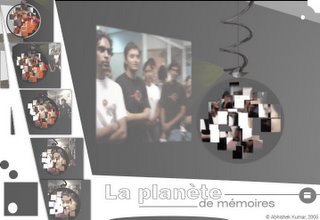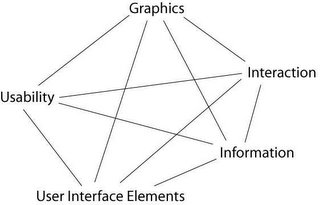Open News portal for Citizen Journalists...
 from my class room project...
from my class room project...
This is my ‘small effort’ to look at things ‘just a little’ differently. This is part of my academic project…which I want to share with you…
IDEA
The genesis of ‘La planète de mémoires’ came from my previous idea of exploring the possibility of projecting images on trees. The idea was to explore the possibilities of projecting images or video in a VOLUME of space rather than on a flat SCREEN. Initially the plan was to project only one projection on the foliage of a tree, but then came the question that as this is a volume space why not project multiple images and create a moving (real time) 3D collage on a volume of space. But due to some reasons the implementation could not take place. But this idea lied latent before I stuck up with another idea – ‘Why not recreate a 3D surface and in case of projection we can have backlit screen.”
This idea is just an exploration of looking at pictures in a different way - spread into 'space'. With digital cameras, we are all flooded with images. The number of images in our lives is mounting so high that we rarely take out time to see them. It display is a Globe (sphere) with small cubes all aligned together inside them. Each side displays a portion of an image so that the combination makes a substantial part of that image. But to be able to see the image one has to conciously stand in position to make sense of it. Else we only see them in parts- as collage of memories (images) in our life. With a projector on the top it also allows you to project an image on any surface …from my project report
…from my project report
© Abhishek Kumar, 2005
The concept of intelligent buildings has been here for quite some time. So I’m not sure where what I’m thinking has been already implemented or not. I was trying to find a project using ‘RFID’ tags, when stumbled upon the idea that “…if I can get a real time data of people inside a building, I can very well build an Intelligent building…”
I searched the MIGHTY ‘internet’ (which is still controlled by the
I came across the web site http://www.aeroscout.com ...its a company which produces Wi-Fi enabled active tags that can be read from a distance of 60 mts inside a building and to about 100 mts outside.
With this kind of technology if I can get a real time data of how many people and where they are inside, then this is what can be done:
Energy Conservation
Security
The RFID tag ‘holder’ itself can be designed to perform multiple tasks like it can work like a ‘pen drive’.
But no doubt there will be privacy issues…but I hope we can find a solution to that...
You can ignore...because its just 'an idea'...
cheers :)
I blog just to share my ideas…that to in a very generic way...
But I thought I should write more into details about my previous post…as one anonymous reader has pointed out…
I guess the idea quoted in the previous posting is not unique…it’s just that I realize a system exists…it will be a huge topic to debate and research…but if I have understood correctly Jesse James Garrett “Elements of User Experience” also in a way states these factors…though he believes its in layers while I believe they are equal and effect each other more strongly…
But someone in the field of UI may (I hope) accept my argument that these are related and I explain this with an example…
Let’s look at various perspectives…
Suppose we start with finding the commands required…and arrange in a logical sequence (information Design)…how many commands are required…which ones are more important >> how many commands we need to add will define the interaction…can all commands be presented to user… >> UI elements are decided by what function each command performs…where it is placed…either all buttons or drop down or mixed >> also the visuals…whether all are in one row or in multiple rows…what icons are required…how many and how to make them different from already existing ones but yet should look like a part of the family…does it starts to dominate the other commands >> Usability consideration would be…are all the icons understood by user…is the terminology of the command correct…are the buttons spaces correct…is the interaction or UI elements fit into the metaphor of existing tools/commands…
So the ‘Experience’ of using that tool bar would come as combined effort of all these factors and not one…if the icon is not properly understood then…even if it is beautifully designed will spoil the experience…or if it is usable but doesn’t look good then also the Experience will suffer…again if the information architecture is not perfect usability will suffer and even a good icon wouldn’t bring the experience…
If we find that there is not enough space for 8 commands, only 5 can be presented…then we have to either think of new interaction model or UI elements or change the information architecture…may be break the tool bar into 2…if they change the visual design would also change and hence the Usability experts again have to evaluate the new design…
This is huge topic to write…but I strongly believe a good design is one which takes care of if not all then MOST parameters…and that’s the key to USER EXPERIENCE…
I would appreciate if readers could mention their names while posting comments…
Thanks & cheers…
© Abhishek Kumar, 2005
Why do we enjoy a good ‘food’??? becoz it has a perfect blend of spices and ingredients. A good cook will tell you that it’s all out ‘just perfect’ mix of ingredients…so its all about knowing and realizing this perfect mix of things for GOOD USER EXPERIENCE in products…
The ingredients involve…
So as a cook (designer) your main aim is to mix them together to make a good dish (product) out of them…skipping one or not mixing one in proper proportions would spoil the taste (experience).

So a good UI would have a good composition…where neither of the above factors dominate but work in harmony with each other…
The graphics should not dominate the information, the UI elements should compliment interaction, the graphic changes with change in UI elements or Interaction, and usability results can changes with change in any of the parameters…so it’s all connected and it’s all a SYSTEM…
Aaaah, free time again…and time to post some ideas…
I just gave an interview and to my horror I was asked…’what I want to be??’....the most difficult question to answer…what can I be??
It’s such a tricky question…either I don’t know the exact meaning or the whole world is confused about it…becoz I never got a clear definition of any of them…
So I though of defining it for myself…
Usability: I believe it’s a field which tries to identify problems in using a product. Also it covers the testing and user research areas.
Information Architecture: Information Architecture is a sub set of Information Design…and what it does is that it tries to simplify and present the information (or commands) in a more understandable and easily perceivable way to the user.
User Interface Designer: UI design basically concentrates on UI elements, their placement on the screen and the composition of the screen.
Graphic Designer: Graphic designer is concerned for the look and feel of the UI. The color schemes ad the icons.
Interaction Designer: Interaction Designer basically handles the interaction of the product. To be an interaction designer one need to have some basic understanding of Graphics, Usability and Information design.
User Experience Designer: User experience designer should come on top of every one. When we talk to ‘experience’, then we should understand that EXPERIENCE come when you have a perfect blend of all elements Graphics, Usability and Information Design. To generate an experience the product should be usable, should be good looking, should have interesting interactions to generate the WOOW effect and should be good in information design (again to make the product easy to use and to find information).
Any one reading this post is welcome to post comments…
I am waiting for some one who can clarify my doubts about these TERMS….